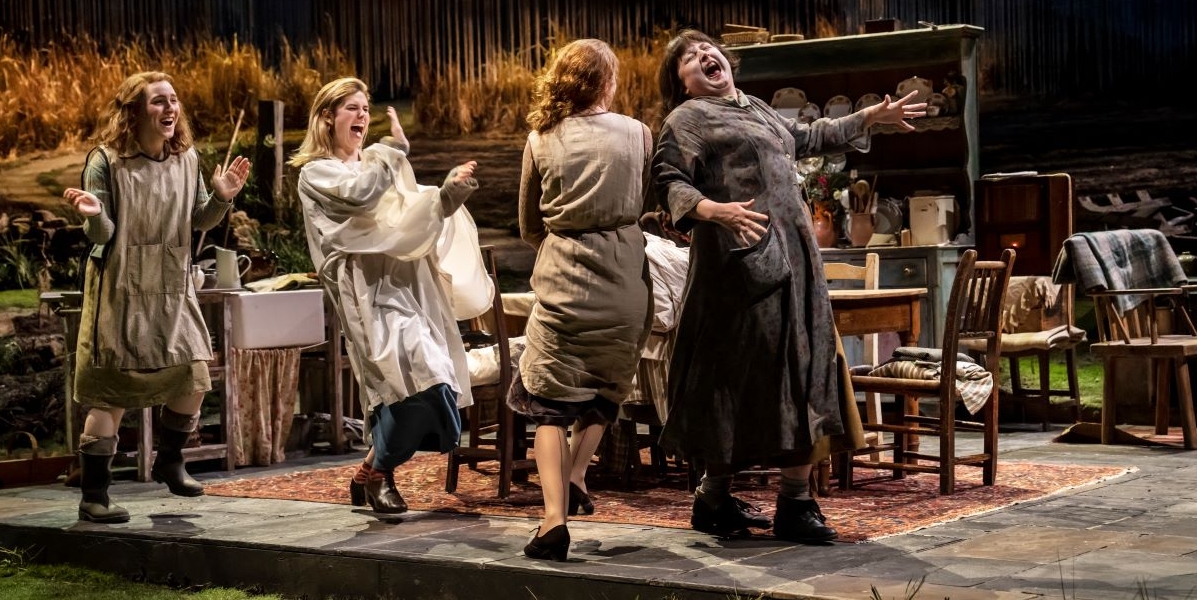‘Atmosphere is more real than incident, and everything is simultaneously actual and illusory’. So says, Michael, the adult narrator in the elegiac monologue that concludes the revival of Brian Friel’s ‘Dancing at Lughnasa’. This production certainly lives up to this dictum. The huge space of the Olivier Theatre is converted by designer Robert Jones into a comprehensive vision of Donegal in high summer. A plain and lived-in farmhouse kitchen with exterior walls removed opens out into a verdant vision of countryside offering garden, crops ready for harvest, a drystone wall, a distant view of mountains seen through a scrim and a huge sycamore tree. It has all the nostalgic glow of ‘Akenfield’ or a painting by Samuel Palmer.
Into this rich tableau come the five Mundy sisters, introduced by Michael. He is recalling the August of 1936, a key moment in this family unit, and by implication in the history of modern Ireland. It is the time of harvest rituals, associated here with the old Celtic god, Lugh. But this is no easy or comforting pastoral vision. This is a world of buffeted precarity that will soon collapse. The presiding figure alongside Lugh is Chekhov, whose meticulous, infinitely humane depictions of the slow, implicit tragedies of ordinary life provide a guiding framework. Each of the sisters, in their different ways, lead unfulfilled and to a degree frustrated lives which are then further disrupted by the insertion of two disruptive male figures – their brother Father Jack, who has just returned in malaria-addled, vague disgrace from missionary work in Africa, and Gerry, the debonair, serially unreliable father of the narrator, Michael, who himself wanders in and out of the action, speaking his lines as both child and grown man.
This is a slow-moving drama, built around domestic rituals rather than plot development, and where the forces of social change are as disruptive as any individual. The economic basis of this household is slipping away as the industrial revolution comes to rural Ireland, undermining claims to respectability and independence. There is one force for good though, the arrival of a radio set, nicknamed ‘Marconi’, which gives them access to folk music and Tin Pan Alley. In a couple of scenes that have become famous the world over the sisters escape collectively into a wild, pagan world of physical exuberance. This is choreographed expertly here by Wayne McGregor, in a way that makes the dancing emerge and come alive anew while preserving the individuality of each of the sister’s self-expression.
In such a character-driven play, the devil lies in the acting detail, and here the cast are outstanding. Each role is expertly delivered so that over above the riches of the text you feel you know them and emote with them through and through by the time we reach the end. These actors also deserve great credit for escaping the shadow of previous, famous interpretations of these parts in theatre and on film. As the head of the family, Kate, Justine Mitchell captures the brittle, scolding self-righteousness of the character while leaving room for some wry humour and self-knowledge. Siobhán McSweeney offers a sharp contrast as the second sister, the earthy, chain-smoking Maggie, with supreme emotional intelligence and generosity of heart. Louisa Harland and Bláithín Mac Gabhann, as down-trodden Aggie and simple-minded Rosie form a natural empathetic pair, the ones who are most vulnerable in the face of change; and Alison Oliver rounds out the group with a complex portrayal of single-mother, Chris. She has to cover the widest emotional range from gentle depression to reluctant, lingering love for her feckless on-off partner, Gerry. He is played by Tom Riley, who perhaps overdoes the effusive mannerisms a tad, even though this is a bit of an underwritten role. Again the two of them are at their best in physical communion of dance. The cast is completed by Ardal O’Hanlon as the confused Father Jack and Tom Vaughan-Lawlor as Michael. O’Hanlon captures the broken yet humane quality of this priest – almost a character out of Graham Greene in the way his dissolution has opened him to inclusivity of vision; and Vaughan Lawlor ascends the technical summit of the final monologue – one of the most famous set-pieces in modern Irish theatre, with rare, dexterous sensitivity and nuance.
While the vast scale of this theatre perhaps makes their task more difficult, director Josie Rourke and this cast ensure that thirty years on from its creation this play continues to touch and move its audience profoundly.

